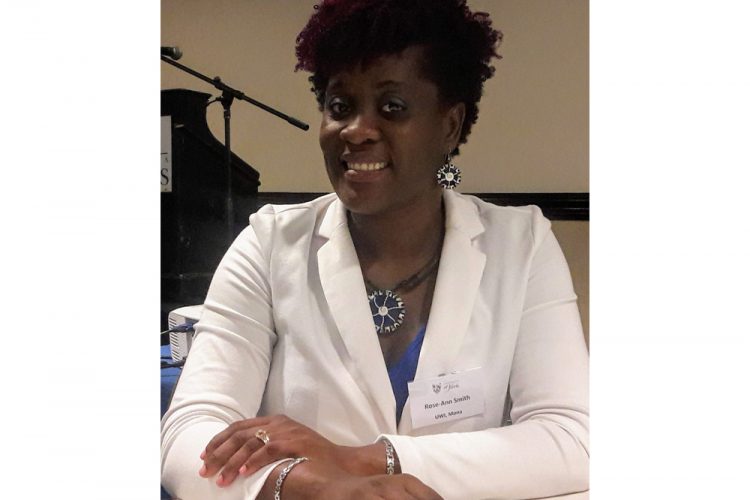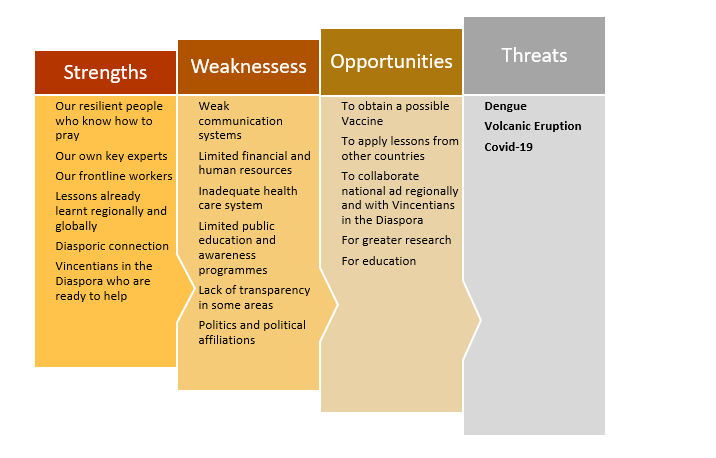Multiple Stresses in St. Vincent and the Grenadines- Ley we do something before something do we!

By Dr Rose-Ann Smith
I want to start by stating that I am a Vincentian living in Jamaica and I hold a PhD in Geography. I lecture at the University of the West Indies in several courses, including Disaster Risk Management. I am also a consultant that has contributed to or led several projects in the area of Disaster Risk Management and Climate Change Adaptation. I was the lead consultant for the United Nations Office for Disaster Risk Reduction (UNDRR), charged with applying the Comprehensive Disaster Risk Management Tool in several Caribbean islands. As much as I do not normally feel it necessary to publicise my credentials, I see this as a necessary preface to content of this article so that what follows will not be viewed as a political tactic but rather a perspective grounded in years of research and experience in a relevant field.
St. Vincent and the Grenadines is currently faced with multiple stresses including Covid-19 and a recent surge in the number of Dengue cases. These epidemiological challenges are compounded by the imminent threat of an effusive volcano which has significant potential to affect lives and livelihoods. This presents a very unique set of challenges as any action for preparedness and response must not only seek to manage these stresses individually, but also collectively. We must also contend with the fact that we are confronted with constraints imposed by limited human and financial resources. It is a difficult challenge for any government or people, but we are a resilient nation.
I am confident we will be able to conquer this challenge if we capitalize on our strengths, address our weaknesses and explore the opportunities for transformation and change. In light of the prevailing circumstances, I will continue this article by offering some advice and suggestions to key stakeholders.
1. Let us continue to lift the nation before God. We have called the country to one day prayer and fasting in the past even when we were faced with less stresses. Let us do it again! We must not forget God as a Christian people and country. However, we have learnt that even as we seek God’s face for direction, it is pertinent that we put measures in place to address the issues at hand as we often acknowledge that faith without works is dead.
2. A critical component of DRM is risk communication. We have to understand our people and our context and ensure that we find efficient and effective strategies to communicate our risk and valuable information. I have seen how false information can spread quickly on social media, but at times this is due to the fact that the truth is not forthcoming, has shortcomings or is simply just slow in coming.
Let us consider and apply the different methods that we can use to communicate. We can rely on our GIS experts to develop interactive maps and dashboards that provide daily updates to the people on different platforms, including social media; but we have to also recognise the different levels of literacy within the country, access to resources and age groups among other things. Accordingly, we need to engage multiple ways of communicating information. At this point, all radio stations, newspapers, TV stations, social media (FB, twitter, Instagram, LinkedIn etc), Non-governmental Organisations (NGOs), bill boards, town criers, telecommunications networks such as Digicel and Flow who are able to send quick alerts and even regional radio stations should be involved in this FIGHT.
On the night of the 16th January, 2021, we saw some residents participating in a hasty south bound exodus. It was the first time many had witnessed the upwelling of hot magma which ignited the dark skies as it gets closer to rim of the crater. They PANICKED! Reports from the UWI Seismic Centre indicate that this volcanic activity has been occurring throughout the day but is more visible at night because of the dark skies. If anything, this tells us that it is not a time to pull each other down with derogatory words alluding to stupidity, as I have seen some do, but to recognise that some may not be as privileged to access and understand certain information and further, to recognise that, amidst all that has been done through NEMO and the UWI Seismic Centre, more needs to be done in relation to clear, understandable and effective information. I personally think that this was a good opportunity to send out a broadcast SMS message, at utilize other media platforms to disseminate relevant information.
We must consider the significance of multiple methods of communication and also recognise the weaknesses in each. For examples, not everyone can read with understanding; not everyone has access to radio and television or even a cellular phone and, at times, the radio station they are tuned into may be on another island. I remembered years ago while doing my PhD research following Hurricane Tomas, I learnt that several persons in the Fancy community never heeded the warning because they never received it. They were tuned into the St. Lucia’s radio station whose signal, they picked up clearer. While much has changed since the last eruption, which occurred about 40 years ago, glaring gaps still exist in our communicative reach. More careful attention must therefore be directed at building knowledge on the nuances of information pipelines accessed and utilized by the population.
It is necessary even as we communicate to ensure that it is not one off and that it is hitting the airwaves at the same time each day. If, for example, we are using radio or TV, persons must be aware of a specific point in time when they would be updated.
I am also making an appeal for more press conferences. There are a lot of questions that the public has that the press can find a way to capture and get the answers from those in authority. We have not been seeing or hearing from some of the very key officials. Part of doing a press conference is to appease the heart of a people who are panicking and show us that amidst the turmoil, even without all the answers, you are standing with us, doing all that you can and, trying multiple things even as you gain more knowledge. Most of all, it gives answers to the many questions that that the Vincentian public have in light of the multiple stresses we face. Let us endeavour to do more in this area.
3. I want to touch briefly on evacuation. I would wish to say more on this, but I have not yet accessed the evacuation plan or learnt of its elements. I have heard Dr. Gonsalves mentioned its existence, but like many others, we are left wondering about the details. Not everyone will be able to pick up an evacuation plan and understand it, but with a volcano that can go off at any time, this is the time to educate the public about the details of the plan. We have no time to lose. We should have already been aware of several things:
Where to move to once the evacuation order is issued? Where are the evacuation points? How do we get there? This information must be given in accordance with where you are coming from. I am aware that some of the very high-risk areas on the Windward side do not have adequate transportation system, particularly Fancy so we need to consider this. Have we sought to assess the assets within each community? How may persons have vehicles and boats and who will be willing to assist in the movement of people especially in light of Covid-19? How have we been appealing to these persons?
How can we ensure that the evacuation process is so smooth that there is no traffic jam or other challenges that may slow down movement? How about persons like farmers who might be in the field at the time the order is given? What should they do immediately after getting that SMS? I am hoping here that they do carry a cell phone but, if not, there are also new challenges to address. The town crier might be useful here.
What about families with disabled, sick and elderlies; how are they incorporated in the evacuation plan? In all of this, we want to also understand how Covid-19 is addressed in the plan. I pray and hope that we do not have to go through such an eruption but should it take place, it is necessary that the public understands ALL information now.
Apart from the need for us to continue to pray and fast, I have focused my attention on communication and evacuation in this article as I believe these are critical at this time. However, even as move forward, I wish to leave with you this SWOT analysis based on some cursory observations. The list is not exhaustive, but it is to tickle our minds that even as we continue to fight the 3-headed monster before us, we must recognise our strengths, acknowledge our weaknesses and seek out opportunities amidst the threats we face.

Biography
Dr. Rose-Ann Smith is a lecturer at the Department of Geography and Geology at the University of the West Indies (UWI), Jamaica where she lectures in several courses including disaster management. Her PhD research examined vulnerability to climate change and climate variability in St. Vincent. Her research interests include Disaster Risk Reduction, Climate Change Adaptation and Sustainable Livelihoods. While her research/consultations have occurred within the Caribbean including Jamaica, St. Vincent, Guyana, BVI and Antigua and Barbuda, several has been funded by international organisations including the World Bank and The United Nation Office for Disaster Risk Reduction (UNDRR). She was the lead consultant for the United Nations Office for Disaster Risk Reduction (UNISDR) with the responsibility of applying the Comprehensive Disaster Management (CDM) audit tool which identifies the strengths and weaknesses in CDM in different Caribbean islands.









